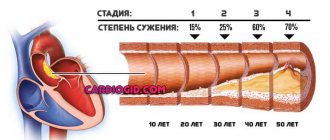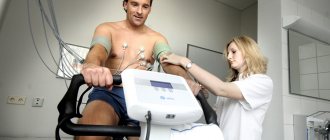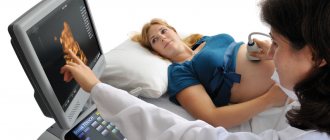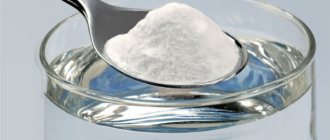I am 68 years old. I’m retired, in the winter I don’t go to many places other than markets and shops, but in the summer I’m actively involved in my dacha. My blood pressure surges started about 10 years ago and began to interfere with my active life. At first there were no special sensations - my head ached, but that happens to everyone. Like everyone else, she said “the weather is changing” or “magnetic storms.” And then my daughter gave me a tonometer. Just out of curiosity, we took the blood pressure and it was 140/100.
Blood pressure problems are easy to miss
I had to go to the doctor and was diagnosed with hypertension. The doctor prescribed pills to lower blood pressure. Everyone accepted what he said. And the doctor also warned that hypertensive patients have exacerbations - crises. He told me what to do in such a situation.
And one day such a crisis happened. Right away I didn’t even understand what was happening. My daughter had problems. Of course, I was worried about her, I didn’t sleep well for a couple of nights. My heart started to hurt, but somehow I got distracted and forgot to measure my blood pressure and take the pills - I had no time for it. And then suddenly my head felt as if my head was being squeezed, everything swam before my eyes. It’s good that I managed to call my daughter and tell her that I felt bad. I only remember that my lips were numb and it was hard to speak. When she arrived, I was already unconscious. At the hospital, the doctor said that it was a hypertensive crisis.
What is a hypertensive crisis and how does it happen?
Hypertensive crisis is a dangerous condition characterized by a sharp and significant increase in blood pressure. In this case, disturbances in the coronary or cerebral blood supply appear or worsen. In such cases, immediate medical attention is required.
In other words, a hypertensive crisis is an exacerbation of arterial hypertension. In this case, the pressure rises to 180/110 mm Hg. and more. At the same time, serious disruptions occur in the functioning of the nervous and cardiovascular systems.
There are several types of hypertensive crisis, based on the accompanying symptoms:
- The uncomplicated form does not cause significant disturbances in the functioning of the brain, heart, or kidneys, and after taking appropriate medications, the pressure normalizes within a few hours.
- Complicated form - in this case, target organs are affected. This could be the heart or lungs, brain or kidneys. This type of hypertensive crisis provokes heart failure and acute coronary syndrome, cerebral and pulmonary edema, stroke and dissection of the aortic aneurysm.
- Hypertensive crisis type I - hyperkinetic - develops quickly, with noticeable tachycardia and a significant increase in blood pressure, especially systolic (above 200 mm Hg).
- Type II crisis - hypokinetic - often occurs in the third stage of arterial hypertension. Symptoms increase gradually, over several hours. There may be no increase in heart rate, but diastolic pressure rises to 140–160 mmHg.
Most often, hypertensive crises occur in older women. The duration of this condition varies: from several hours to several days.
However, this does not mean that everyone else is safe. Hypertensive crisis can occur at a young age. Such pathologies are also recorded in 20-year-olds, although less frequently than in older people. Basically, this is a manifestation of hypertension, which a person might not even suspect.
Recently, hypertensive crises are increasingly occurring in children, especially teenagers. Hormonal changes in the body, a hereditary tendency to hypertension, stress, for example, due to exams, provoke pressure surges, which in no case should be ignored. There was even a separate term “juvenile hypertension”.
In fact, a hypertensive crisis can happen at any age, so everyone needs to control their blood pressure.
Treatment of hypertensive crisis: a view from the perspective of evidence-based medicine
With regard to arterial hypertension (AH), both in the world and in the Russian Federation, there are clear standards for the selection of drug therapy, and the issues of definitions and classification are also relatively clear [1-3]. However, the actual implementation of these standards is quite slow and the recommendations on the choice of drugs and the goals of therapy are not always followed in practice. One of the most problematic areas in this regard is the provision of emergency care for hypertensive crises. These conditions in practical healthcare still have an ambiguous interpretation of the definition and even greater individual differences in the choice of treatment measures, based on outdated ideas, personal experience and subjective judgments. At the same time, issues of chronic therapy of hypertension are most often discussed in the press, and the treatment of emergency conditions, and in particular hypertensive crises, is not sufficiently covered. This circumstance is apparently connected, on the one hand, with the fact that insufficient attention is paid to similar issues even in international recommendations. On the other hand, international standards for the treatment of emergency conditions differ significantly from traditional domestic concepts and are more difficult to implement in practice, since they involve the use of drugs or their forms that are not widely used in Russia or do not even have state registration. In addition, if for the development of long-term treatment tactics for arterial hypertension, standards and recommendations are based on the results of numerous prospective clinical studies, i.e. based on the principles of evidence-based medicine, then in relation to immediate tactics for a number of emergency conditions, these results of long-term observations are not available today. Finally, the treatment of emergency conditions in most cases lies outside the scope of cardiology as a specialty and involves the participation of other specialists, which further complicates the unification of medical tactics. This review is devoted to standardized approaches to the treatment of conditions associated with acute elevation of blood pressure, based on evidence-based medicine in the light of currently available international and Russian recommendations. The authors set the task of summarizing the available data on the pathophysiological mechanisms of hypertensive crises, as well as the immediate and long-term results of various treatment regimens, primarily from the standpoint of effective and safe use, which is the basis of the principle of evidence-based medicine. Despite this, many issues of the treatment of hypertension in acute situations are still controversial, and the treatment methods used are not sufficiently proven, which is also drawn to the attention of readers.
Definition. According to the 2001 GFOC recommendations [1], today the concept of hypertensive crises and their classification is brought into line with international concepts (JNC recommendations [2]). These conditions include all cases where a sharp and significant increase in blood pressure led to a particular situation that poses an immediate danger to the patient. Since the basis for medical tactics in this case is not so much the level of blood pressure or the pathogenetic mechanism that led to its increase, but the complication that has arisen and, accordingly, the urgency of medical measures, all conditions that require a rapid decrease in blood pressure to one degree or another are divided into into two large groups.
1. Conditions requiring emergency treatment (hypertensive emergencies) (lowering blood pressure within the first minutes and hours using parenterally administered drugs).
Emergency treatment requires an increase in blood pressure that leads to the appearance or worsening of symptoms from target organs - unstable angina, myocardial infarction, acute left ventricular failure, dissecting aortic aneurysm, eclampsia, stroke. An immediate reduction in blood pressure may also be required in case of injury to the central nervous system, in postoperative patients with a risk of bleeding, etc. Treatment of such conditions is carried out, as a rule, in a hospital in an intensive care unit.
2. Conditions that require a decrease in blood pressure over several hours (hypertensive emergencies). In itself, a sharp increase in blood pressure, not accompanied by the appearance of symptoms from other organs, requires mandatory, but not so urgent, intervention and can be stopped by oral administration of drugs with a relatively rapid effect. Treatment of uncomplicated hypertensive crisis is possible without hospitalization.
Thus, the absolute level of blood pressure is not a criterion for the diagnosis of hypertensive crisis. It should be noted that the majority of patients hospitalized for this indication have a diastolic blood pressure level of more than 120 mm Hg. Art. [4].
Pathogenesis. Note that the classical ideas about blood pressure as a product of cardiac output and vascular resistance have not changed today and the fact is still not denied that to increase blood pressure, either an increase in cardiac output or intravascular fluid volume, or increased vasoconstriction, or a combination of these reasons is necessary. The participation of the renin-angiotensin system in the rise in blood pressure can vary from a key role in conditions such as malignant hypertension syndrome, to an insignificant role in the predominance of sodium and water retention (eclampsia). In this regard, the approach to treating patients based on renin plaza activity (RPA) is considered very promising in the world [5]. If it is high, then the most effective drugs will be ACE inhibitors, angiotensin II receptor antagonists and β-blockers; if the ARP is low, then the effect is achieved only from diuretics, α-blockers or calcium channel blockers. Unfortunately, such an approach is applicable only if there is sufficient time and technical capabilities to evaluate the ARP; the latter circumstance limits its use in our country.
General principles of treating a patient with a crisis. The situation of choosing a drug in a patient with a crisis is complicated by the paucity of available examination data, the need for quick decision-making and the presence of complications that may determine this choice.
In Russia, this is aggravated by logistical and technical difficulties (assessment of the level of ARP, catecholamines, the possibility of magnetic resonance examination methods, etc.).
- When treating a crisis, you should initially identify the signs that determine the degree of urgency to lower blood pressure. In addition, a number of medical history data may allow us to establish the immediate cause of a sharp increase in blood pressure (withdrawal syndrome of certain medications, the use of concomitant therapy, etc.).
- Laboratory tests include serum electrolytes, creatinine, complete blood count, and urinalysis. An electrocardiogram and a chest x-ray are mandatory. If technically possible, blood is taken for catecholamines and APR, despite the fact that the results of such an analysis can be obtained no earlier than in a day.
- It is necessary to pay special attention to the possibility of dissecting aortic aneurysm, since in this case the management tactics change.
- If there is no suspicion of aortic dissection, drugs that affect different parts of the pathogenesis should be used in turn. The presence of an effect or its absence will serve as an indicator of the compliance of the treatment with the main pathogenetic mechanism of the rise in blood pressure, since in this case this is the only guideline. As a first line, it is advisable to use drugs that block the renin-angiotensin system (RAS) - an ACE inhibitor (Table 1). Then a mixed-action drug (α- and β-blocker) is used to determine the possible contribution of the catecholamine mechanism and, finally, the last pathogenetic link is tested - fluid retention and furosemide is prescribed. The order of drug prescription may vary depending on the individual characteristics of the patient and the clinical situation, in particular the likelihood of side effects [5]. Phentolamine becomes the drug of first choice if a crisis with pheochromocytoma is suspected, diuretics - with an obvious clinical and anamnestic picture of a water-salt crisis. If there are contraindications for β-blockers (bronchial asthma), ganglion blockers or non-dihydripridine calcium antagonists are used.
Table 1. Drugs for the treatment of hypertensive crises
| for parenteral administration | ||
| ACE inhibitors | Captopril | Enalaprilat |
| Diuretics | Furosemide | Furosemide |
| Centrally acting drug | Clonidine Guanfacine | |
| β-blockers | Metoprolol | Esmolol Metoprolol |
| α-blockers | Prazosin Terazosin Doxazosin | Phentolamine |
| α- and β-blockers | Labetalol Carvedilol | Labetalol |
| Peripheral vasodilator | Sodium nitroprusside |
Basic drugs for the treatment of crises
ACE inhibitors. In most cases, this group of drugs is recommended to be used first, since their use helps to simultaneously answer the question of the participation of the RAS in the pathogenesis of this condition and block the toxic effects of angiotensin II on the vascular wall in malignant hypertension. These drugs are also preferred in patients with heart failure, including acute left ventricular failure, and acute coronary syndrome. They are contraindicated in pregnant women with eclampsia. Of the recommended drugs, captopril orally and enalaprilat administered intravenously provide a decrease in blood pressure within the first hour.
Antiadrenergic drugs. Phentolamine (if pheochromocytoma is suspected) has an immediate effect. A quick answer involves testing for pheochromocytoma. α-blockers are also effective for low-renin hypertension.
Diuretics (furosemide). They are used for volume-dependent crises, as well as in patients with symptoms of heart failure. The effect is achieved within 30-60 minutes. The dose can be increased until a diuretic response occurs.
Centrally acting drugs. Indicated for withdrawal syndrome of this group of drugs. In such patients, α- and β-blockers may also be used simultaneously.
Sodium nitroprusside. This drug, when administered intravenously, has an extremely rapid effect and, with flexible dosing, provides controlled blood pressure control. These advantages make it indispensable in a number of situations, for example, when it is necessary to lower blood pressure before surgery. However, the use of nitroprusside can cause an excessive hypotensive response, which can lead to serious consequences in some patients.
Administration of sodium nitroprusside requires invasive blood pressure monitoring in the intensive care unit. We should not forget that this drug is toxic and promotes the formation of cyanhemoglobin at high rates of administration. Toxicity is aggravated in patients receiving diuretics, as well as during surgical interventions [6].
Among other drugs, antipsychotics (droperidol), used in acute coronary syndrome and in a number of other situations, can effectively lower blood pressure.
In the presence of threatening complications (hypertensive emergencies), blood pressure should be reduced by 25% in the first 2 hours and to 160/100 mm Hg. Art. over the next 2-6 hours. Blood pressure should not be reduced too quickly to prevent ischemia of the central nervous system, kidneys and myocardium. When the blood pressure level is above 180/120 mm Hg. it should be measured every 15-30 minutes.
When treating a patient with an uncomplicated hypertensive crisis on an outpatient basis, oral medications are used: β-blockers (metoprolol), calcium antagonists (nifedipine), clonidine, short-acting ACE inhibitors (captopril), α-blockers (prazosin, terazosin). A decrease in blood pressure in the absence of significant target organ damage should be carried out gradually over 24-48 hours to avoid its possible sharp drop.
Special situations
Hypertension and stroke
ACVA of ischemic type. Almost 80% of patients with ischemic stroke experience an increase in blood pressure to varying degrees. However, the treatment of hypertension in this category of patients still remains controversial. This is due, first of all, to the fact that blood pressure during a stroke spontaneously decreases to the initial level after 4 days [7]. The question of tactics - the speed and degree of blood pressure reduction in patients with acute cerebrovascular accident should be considered from the standpoint of changes in the autoregulation of cerebral blood flow. It should be remembered that the lower limit of autoregulation in patients with hypertension is significantly higher than in healthy individuals, and a decrease in blood pressure even by 25% of the initial value may be accompanied by a deterioration in blood flow in ischemic areas of the brain [8]. In this aspect, a number of randomized controlled studies are of interest, which have demonstrated that lowering blood pressure in patients with stroke may not improve prognosis. Thus, in a study that was designed to answer the question of the advisability of using tissue plasminogen activators in patients with ischemic stroke, the prescription of antihypertensive therapy was accompanied by a 4-fold increase in the risk of death and a worse neurological prognosis [9].
In another controlled application, the use of nimodipine in patients with ischemic stroke led to an increase in mortality in the first months from the onset of the disease [10]. Apparently, the choice of drug is important for changes in cerebral blood flow. Thus, a number of studies have shown that the administration of ACE inhibitors, α-blockers and clonidine is relatively safe for blood circulation in the ischemic area and prognosis [11].
Stroke of hemorrhagic type. In this case, hypertension is observed in almost all patients and is not prone to spontaneous regression. Nimodipine has proven itself to be a drug that provides a significant improvement in the prognosis of patients with subarachnoid hemorrhage [12], which, however, can cause significant hypotension when administered intravenously and determine the subsequent prescription of vasopressors. The use of nifedipine in this case is more problematic, since a possible decrease in perfusion pressure has been shown, and the long-term prognosis of such patients has not been assessed [12].
Relatively favorable results were obtained in patients with hemorrhage due to aneurysm rupture when treated with nicardipine [14].
Thus, today the treatment of hypertension in a patient with stroke still seems problematic from the point of view of the available evidence of its benefit and safety. The effectiveness of active antihypertensive therapy for ischemic strokes has not been proven, and the use of calcium antagonists in patients with cerebral hemorrhages is often limited by hypotensive reactions [15, 16].
Dissecting aortic aneurysm
Arterial hypertension occurs in almost all patients with aortic dissection. Among the main factors that provide the risk of aortic dissection are blood pressure, the number of heartbeats and the contractile force of the myocardium itself, which generally provides the strength of the pulse wave. Naturally, the basis of drug therapy in patients with suspected aortic dissection will be β-blockers and/or ganglion blockers. In case of insufficient effectiveness and preparation for surgery, the administration of sodium nitroprusside is recommended. The use of calcium channel blockers is permissible only with the simultaneous administration of β-blockers. The target blood pressure level in this case is the minimum tolerated [5, 17].
Myocardial infarction
Treatment of myocardial infarction, including long-term prognosis, is the most studied problem. β-blockers and ACE inhibitors increase patient survival and are first-line drugs [18-20]. Despite the good antihypertensive effect, the use of calcium channel blockers of the dihydropyridine group is not recommended in the presence of acute myocardial ischemia. The use of sodium nitroprusside may be accompanied by an increase in the ST segment, while nitroglycerin, when administered intravenously, provides an equally reliable reduction in blood pressure and an anti-ischemic effect [21].
Preeclampsia-eclampsia
Until now, the pathophysiological mechanisms of development of this syndrome remain unknown. Hypertension in pregnant women is characterized by increased vascular sensitivity to pressor agents, primarily to angiotensin II, as well as severe endothelial dysfunction.
α-methyldopa is traditionally considered the drug of choice for the treatment of hypertension in pregnant women due to the absence of teratogenic effects. In severe hypertension, preeclampsia and eclampsia, the list of drugs that are safe and effective when used parenterally is very limited. Labetalol is effective, as is hydralazine, but the latter causes tachycardia, hypotension and fluid retention. Alternative drugs are calcium antagonists. ACE inhibitors and diuretics are contraindicated. Sodium nitroprusside should be used with extreme caution in this category of patients [22]. An effective method of lowering blood pressure is the administration of magnesium sulfate, which is mandatory when there is a threat of seizures or their occurrence [23].
Thus, there are still many “blank spots” in the treatment of hypertensive crises. This is due to the fact that patients with emergency pathology are not optimal subjects for clinical trials and the long-term effects of therapy have not been sufficiently studied. Most of the drugs currently used effectively in the treatment of crises have never been tested in randomized clinical trials. The adopted treatment regimens are largely empirical and are based on known pathophysiological mechanisms, clinical experience and pharmacological properties of the drugs [5, 24]. The standard approach to treating these conditions is to quickly, but not excessively, lower blood pressure. In treating a patient, one should be guided by the goal not of lowering blood pressure per se, but of reducing damage to target organs, which requires taking into account the possible development of their hypoperfusion. The choice of drug should be based on the existing complications and the main pathogenetic mechanisms underlying the increase in blood pressure, and also take into account possible side effects.
Table 2. Choice of drug for emergency conditions associated with increased blood pressure
Condition
| Drugs of choice | Comments | |
| Dissecting aortic aneurysm | β-blocker (esmolol) Labetalol Sodium nitroprusside plus β-blocker | Avoid hydralazine. Reduce blood pressure to the lowest possible values |
| Acute coronary syndrome | β-blockers ACE inhibitors Nitroglycerin | Gradual reduction in blood pressure Avoid direct vasodilators |
| Acute cerebrovascular accident | Hemorrhage - nimodipine Esmolol, labetalol Sodium nitroprusside | For ischemic type: ACE inhibitor, clonidine, the feasibility of rapidly lowering blood pressure is questionable |
| Eclampsia | Hydralazine, α-methyldopa, labetalol, urapidyl Magnesium sulfate (convulsive syndrome) | Avoid ACE inhibitors, angiotensin II receptor antagonists, diuretics, sodium nitroprusside |
| Acute left ventricular failure due to hypertension during surgical interventions | Sodium nitroprusside Nitroglycerin Enalaprilat Furosemide Morphine Sodium nitroprusside Nitroglycerin (especially after coronary surgery) | Avoid β-blockers, hydralazine There is a risk of thrombosis with hypotension |
| Catecholamine crisis | Phentolamine Labetalol | Avoid diuretics |
| Kidney failure | Hydralazine, labetalol | Avoid β-blockers |
| Elderly patients | Using lower doses of all medications | A rapid decrease in blood pressure is more dangerous. The danger of orthostatic hypotension |
| Clonidine withdrawal syndrome | Clonidine Labetalol Phentolamine + β-blocker | Transdermal form of clonidine may be used |
Causes of development of hypertensive crisis
The causes of a hypertensive crisis can be single or complex. One of them is associated with refusal to take medications to lower blood pressure by people with arterial hypertension. This situation is called “withdrawal syndrome.” Incorrect use of antihypertensive drugs can also cause similar consequences. Other reasons include:
- Diseases of the heart, thyroid gland, adrenal glands or kidneys;
- Preeclampsia during pregnancy;
- Head injuries;
- Serious burns;
- Use of amphetamine, cocaine;
- Abuse of alcohol and nicotine;
- Heavy physical activity;
- Stressful conditions;
- Eating too much;
- Sudden changes in atmospheric pressure.
A hypertensive crisis can be triggered by excess salt consumption, excess weight, and a sedentary lifestyle.
Causes
The cause may be various factors. GK usually develops if the patient has arterial hypertension of any origin (hypertension or symptomatic manifestations of hypertension). In addition, HA can often occur with abrupt withdrawal of drugs that lower blood pressure (hypotensive medications). This condition is also called “withdrawal syndrome.”
External reasons include:
- stress;
- weather changes;
- excessive consumption of table salt;
- excessive physical activity;
- excessive alcohol consumption;
- hypokalemia.
Symptoms and signs
Sometimes the only symptom of a hypertensive crisis is a significant increase in blood pressure. In other cases, a feeling of fear and causeless anxiety, chills and tremors, attacks of vomiting and a feeling of pulsation in the temples appear. A sign of this condition is often a sharp headache, mainly in the back of the head.
Hypertensive crisis may be accompanied by:
- Shortness of breath (cause - increased load on the left ventricle of the heart);
- Visual impairment, for example, flashing “spots” before the eyes, double vision or partial loss of visual fields;
- Compressive pain behind the sternum;
- Redness of the skin;
- Numbness of the hands and face, sensation of crawling goosebumps;
- Reduced pain sensitivity in the lips, tongue, face;
- Cramps;
- Rapid heartbeat;
- Feeling hot, sweating;
- Feeling of intense thirst.
At the end of the crisis, excessive urination is possible with the release of light-colored urine. In severe cases and in the absence of medical care, the risk of coma, thrombosis, arterial embolism, and acute renal failure increases.
Diagnosis of hypertensive crisis
Since the symptoms of a hypertensive crisis are similar to the manifestations of some other diseases, it is important to correctly diagnose the pathology to prescribe treatment. Several methods are used for this:
- Measuring blood pressure throughout the day;
- Electrocardiogram;
- Examination of the fundus for hemorrhages and swelling;
- Urine and blood tests;
- X-ray to monitor the condition of the chest organs.
To rule out a stroke, a computed tomography scan is performed. To diagnose a hypertensive crisis, the doctor must have complete information about the time of onset of attacks, the frequency of their occurrence, symptoms, medications that the person is taking, and the presence of concomitant diseases.
Features of the treatment process
After stopping the jump in blood pressure, the patient must be examined for the condition of the target organs that suffer more than others during a crisis. These are the heart, brain, internal organs, eyes. For this purpose, the following examination methods are used:
- ECG;
- general urine and blood tests;
- taking blood for markers of infarction;
- Ultrasound of the heart and abdominal organs;
- MRI.
The patient is examined by specialized specialists - a neurologist, cardiologist, and ophthalmologist. This is the standard required to get the full picture. The data make it possible to draw up an optimal treatment regimen for an uncomplicated crisis, including long-acting antihypertensive drugs, emergency medications for a sharp rise in pressure; diuretics that reduce the load on blood vessels and the heart; nootropic drugs that protect the brain from the unpredictable effects of a crisis; sedatives that relieve a panic attack and calm a patient for whom the crisis has become a serious stress; antispasmodics for vasodilation.
Nitroglycerin is prescribed for various types of crises to prevent heart damage
If a complicated type of disorder is diagnosed, treatment is possible only in a hospital setting. Often a patient is transported from an ambulance to an intensive care ward, since every minute can be fatal.
Treatment and first aid
The main task in the treatment of a hypertensive crisis is a gradual decrease in blood pressure to acceptable levels. It is important that in the first 2 hours after the attack the pressure decreases by no more than 25%.
In the future, drug therapy is prescribed based on the individual characteristics of the body. Medicines should be selected by a doctor; self-medication in such a situation can be very dangerous. For example, with uncontrolled use of drugs that lower blood pressure, uncontrolled hypotension may develop.
In an uncomplicated form of hypertensive crisis, you should immediately stop physical activity, sit or lie down so that your head is elevated, and measure your blood pressure. You need to calm down, take a few deep breaths and exhales, you can take herbal sedatives, for example, valerian tincture. If a crisis occurs for the first time in your life, you should definitely call an ambulance.
In case of a complicated form, medical attention is required in any case. The person needs to be given the same position as in the previous case to avoid ortapnea - attacks of suffocation. The feet and legs should be warmed with a heating pad. It is also necessary:
- Provide fresh air flow (open a window or window);
- Give the person the medicine with which he usually lowers his blood pressure;
- For severe headaches, give a diuretic tablet that the person uses;
- In any case, do not give new medications that he has not used before;
- Provide psychological support, trying to reduce stress and prevent panic.
The need for other measures, including hospitalization, is determined by the doctor. If a person stays at home, his blood pressure should be measured an hour after taking the medication. This can be done using a home automatic blood pressure monitor, which must be in the first aid kit for people who have problems with blood pressure.
Prevention
If timely and adequate medical care was provided, then the prognosis for the development of a crisis is conditionally favorable. Death in this case is a rare occurrence, primarily associated with complications that arise against the background of a too rapid rise in blood pressure. This may be pulmonary edema, stroke, myocardial infarction, heart failure, etc.
To avoid a hypertensive crisis, it is necessary to adhere to the antihypertensive therapy prescribed by the doctor, constantly monitor blood pressure levels, limit the amount of salt and fatty foods consumed, closely monitor body weight, do not drink alcohol or smoke, try not to get into stressful situations, and increase physical activity.
If the patient has symptomatic arterial hypertension, you should consult with specialists - a neurologist, endocrinologist, nephrologist.
If you have hypertension and are at high risk of developing a hypertensive crisis, the ABC-MEDICINE clinic will provide you with qualified assistance. Here, professional doctors with many years of experience will develop a treatment plan for you, prescribe the necessary examinations and drug therapy. Thanks to modern technology and an individual approach to each patient, we are able to provide high-quality medical care to both adults and children. Make an appointment with our cardiologists by phone +7 (495) 223-38-83.
After a hypertensive crisis I had to stay in the hospital
I then spent more than two weeks in the hospital. When I was discharged, the doctor told me to be sure to measure my blood pressure in the morning and evening and take medications. And if the pressure is high, immediately go to the clinic or call a doctor.
That’s when the tonometer my daughter gave me came in very handy. I once tried to master the old tonometer, which was still mechanical. But you can’t measure your own blood pressure with it. And my blood pressure monitor is very easy to use: you put on the cuff and press the button, you don’t need anything else.
It is very convenient that all results are saved in memory. My daughter showed me how they can be transferred to her computer. While the pressure is not bothering me, the medications are probably helping. But I measure it every day: it’s not difficult, but I don’t want a repeat of the crisis, it was very scary. I go to the doctor once every 2-3 months. My daughter prints out all the measurement results for me, and from them the doctor can see whether anything needs to be changed in the medications. And it’s also good that the device itself is small; in the summer I take it to the dacha - you never know.
Preventive measures
The main measure to prevent a hypertensive crisis is regular measurement of blood pressure: in a sitting position, in the mornings and evenings, with mandatory recording of the results. They can be recorded in a paper diary, stored in the tonometer’s memory, or transferred via an application to a smartphone or computer, if the device has such a function. Subsequently, the data must be shown to the attending physician so that he can assess the dynamics. If your blood pressure is high, you should consult a doctor.
Preventive measures also include:
- Control of chronic diseases of the kidneys, adrenal glands, thyroid gland;
- Drawing up an optimal diet, which should contain vegetables and fruits, dairy products and whole grain bread, foods rich in potassium and magnesium;
- Limiting salt intake;
- Rejection of bad habits;
- Optimal physical activity;
- Weight control and, if necessary, weight loss.
To reduce the risk of developing a hypertensive crisis, you need to avoid stressful situations and learn to manage your psycho-emotional state, avoid physical overload, and take medications prescribed by your doctor to lower your blood pressure.
Recovery after an attack
When the crisis has subsided and the pressure has returned to normal, the patient needs some time to recover. And every body recovers differently. One patient needs to follow doctor's recommendations for 2 weeks, others may feel worse than usual for several months.
During this period, headaches, weakness, and fluctuations in blood pressure are common. Antihypertensive drugs, usual analgesics and other medications, previously agreed upon with the attending physician, help combat the disorders.
Recovery from a hypertensive crisis necessarily includes changes in your usual diet. The basis of the diet is food rich in valuable vitamins and microelements, which has a beneficial effect on the entire body weakened by the crisis, namely:
- magnesium-containing foods - spinach, seaweed, buckwheat, oatmeal, millet, broccoli, seafood, prunes;
- Potassium-rich foods - trout, dried apricots, citrus fruits, black currants, bananas;
- dairy products;
- steamed and baked vegetables;
- low-fat sea fish cooked without fat.
The diet during a hypertensive crisis and during recovery after it excludes the consumption of fast food and other foods that are not valuable for health
Salty, smoked and spicy foods that can cause fluid retention are prohibited. It is worth excluding from your diet foods that cause increased gas formation (legumes, carbonated drinks, baked goods).








